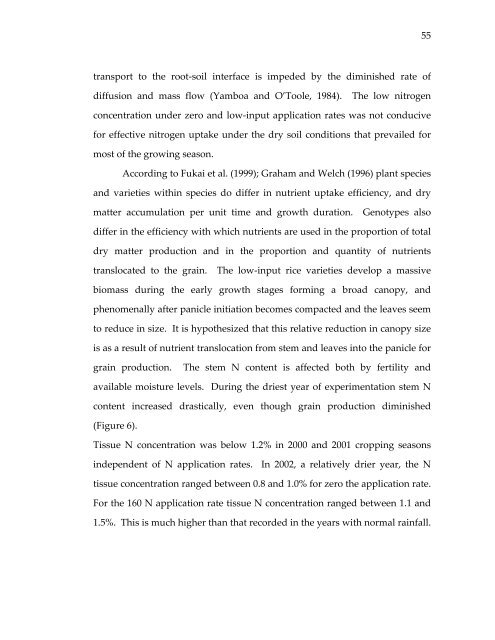Management of rice production systems to increase productivity
Management of rice production systems to increase productivity
Management of rice production systems to increase productivity
You also want an ePaper? Increase the reach of your titles
YUMPU automatically turns print PDFs into web optimized ePapers that Google loves.
transport <strong>to</strong> the root‐soil interface is impeded by the diminished rate <strong>of</strong><br />
diffusion and mass flow (Yamboa and O’Toole, 1984). The low nitrogen<br />
concentration under zero and low‐input application rates was not conducive<br />
for effective nitrogen uptake under the dry soil conditions that prevailed for<br />
most <strong>of</strong> the growing season.<br />
According <strong>to</strong> Fukai et al. (1999); Graham and Welch (1996) plant species<br />
and varieties within species do differ in nutrient uptake efficiency, and dry<br />
matter accumulation per unit time and growth duration. Genotypes also<br />
differ in the efficiency with which nutrients are used in the proportion <strong>of</strong> <strong>to</strong>tal<br />
dry matter <strong>production</strong> and in the proportion and quantity <strong>of</strong> nutrients<br />
translocated <strong>to</strong> the grain. The low‐input <strong>rice</strong> varieties develop a massive<br />
biomass during the early growth stages forming a broad canopy, and<br />
phenomenally after panicle initiation becomes compacted and the leaves seem<br />
<strong>to</strong> reduce in size. It is hypothesized that this relative reduction in canopy size<br />
is as a result <strong>of</strong> nutrient translocation from stem and leaves in<strong>to</strong> the panicle for<br />
grain <strong>production</strong>. The stem N content is affected both by fertility and<br />
available moisture levels. During the driest year <strong>of</strong> experimentation stem N<br />
content <strong>increase</strong>d drastically, even though grain <strong>production</strong> diminished<br />
(Figure 6).<br />
Tissue N concentration was below 1.2% in 2000 and 2001 cropping seasons<br />
independent <strong>of</strong> N application rates. In 2002, a relatively drier year, the N<br />
tissue concentration ranged between 0.8 and 1.0% for zero the application rate.<br />
For the 160 N application rate tissue N concentration ranged between 1.1 and<br />
1.5%. This is much higher than that recorded in the years with normal rainfall.<br />
55
















